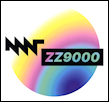
ZZ9000 Compendium
More than a modern Amiga graphics card
Compiled by a ZZ9000 owner and enthusiast
Updated: March 25, 2023 | ZZ9000 is © 2019-2023 MNT Research GmbH
 ZZ9000 CompendiumMore than a modern Amiga graphics card Updated: March 25, 2023 | ZZ9000 is © 2019-2023 MNT Research GmbH |
Preface | Specifications | Requirements / Compatibility | Production / Shipping | Installation | Screen Modes
Add-Ons | Apps 'n ARMs | Benchmarks | Features | Support / Troubleshooting | F.A.Q. | Links | Contact
For the new way you donít need any special tools except HDInstTools (recommended) or HDToolBox (has trouble with big disks). Warning! Never switch between apps (e.g. HDInstTools, HDToolBox—even different release versions of HDToolBox, such as OS 3.1.4 vs. OS 3.9) to modify the same device, or you will encounter problems. Each app calculates and establishes device parameters differently!
MountDOS zzusb.device FAT95 MountIcon Information on the HDInstTools icon and enter zzusb.device as the DEVICE in Tool Types (i.e. DEVICE=zzusb.device).You can then access the partitions on another computer. Linux has native support for RDB and Amiga OFS/FFS, so you can just mount the partitions like:
mount -t affs /dev/sda1 /mnt
On Windows/Mac, I think you have to use UAE and allow it to use the whole USB stick device as a raw disk.
A: The Altais monitor file (temporarily stored in DEVS:Monitors) and the Altais.card file (temporarily stored in LIBS:Picasso96) need to be deleted after the ZZ9000 monitor driver has been created by the ZZ9000 Installer during initial installation. That should fix this error, and prevent the ZZ9000 Installer from failing to install any driver updates.
A: As of firmware/driver release v1.8, 256 MB of AutoConfigTM Fast RAM (from the ZZ9000) is automatically added to your (Zorro III-only) AmigaOS. If you choose to add RAM manually, you can safely add (and use) up to 192 MB of the ZZ9000's RAM to your Amiga's Fast RAM (see "Adding ZZ9000 RAM to your Amiga's Fast RAM" in Apps 'n ARMs). As code contributor _Bnu notes:
"Technically, you can add more than 192 MB, but the scratch area is somewhere around 52 MB in ZZ9k memory, and was designed to hold an amount of arbitrary data that would never be limiting for any reasonable data it might hold (like memory buffered files, frame buffers, etc.). So the first 64 MB are kind of soft-partitioned off to be used internally by the card. Note that while the ZZ9000's RAM is technically faster than the RAM on other Amiga expansions (e.g. BigRamPlus), it is also higher latency since it is DDR rather than SDRAM."
Please see the MNT ZZ9000 ARM SDK for information regarding memory sharing between the Amiga and ARM apps.
A: (answer will be posted when available)
A: (answer will be posted when available)